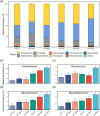Carbendazim shapes microbiome and enhances resistome in the earthworm gut
- PMID: 35436900
- PMCID: PMC9014604
- DOI: 10.1186/s40168-022-01261-8
Carbendazim shapes microbiome and enhances resistome in the earthworm gut
Abstract
Background: It is worrisome that several pollutants can enhance the abundance of antibiotic resistance genes (ARGs) in the environment, including agricultural fungicides. As an important bioindicator for environmental risk assessment, earthworm is still a neglected focus that the effects of the fungicide carbendazim (CBD) residues on the gut microbiome and resistome are largely unknown. In this study, Eisenia fetida was selected to investigate the effects of CBD in the soil-earthworm systems using shotgun metagenomics and qPCR methods.
Results: CBD could significantly perturb bacterial community and enrich specific bacteria mainly belonging to the phylum Actinobacteria. More importantly, CBD could serve as a co-selective agent to elevate the abundance and diversity of ARGs, particularly for some specific types (e.g., multidrug, glycopeptide, tetracycline, and rifamycin resistance genes) in the earthworm gut. Additionally, host tracking analysis suggested that ARGs were mainly carried in some genera of the phyla Actinobacteria and Proteobacteria. Meanwhile, the level of ARGs was positively relevant to the abundance of mobile genetic elements (MGEs) and some representative co-occurrence patterns of ARGs and MGEs (e.g., cmx-transposase and sul1-integrase) were further found on the metagenome-assembled contigs in the CBD treatments.
Conclusions: It can be concluded that the enhancement effect of CBD on the resistome in the earthworm gut may be attributed to its stress on the gut microbiome and facilitation on the ARGs dissemination mediated by MGEs, which may provide a novel insight into the neglected ecotoxicological risk of the widely used agrochemicals on the gut resistome of earthworm dwelling in soil. Video abstract.
Keywords: Antibiotic resistance genes; Fungicide; Gut microbiota; Manure; Mobile genetic elements; Soil animal.
© 2022. The Author(s).
Conflict of interest statement
All authors declare that they have no competing interests.
Figures






Similar articles
-
Long-term application of organic fertilization causes the accumulation of antibiotic resistome in earthworm gut microbiota.Environ Int. 2019 Mar;124:145-152. doi: 10.1016/j.envint.2019.01.017. Epub 2019 Jan 11. Environ Int. 2019. PMID: 30641258
-
Enantioselective effect of the chiral fungicide tebuconazole on the microbiota community and antibiotic resistance genes in the soil and earthworm gut.Sci Total Environ. 2023 Nov 1;897:165381. doi: 10.1016/j.scitotenv.2023.165381. Epub 2023 Jul 6. Sci Total Environ. 2023. PMID: 37422227
-
Viral Communities Suppress the Earthworm Gut Antibiotic Resistome by Lysing Bacteria on a National Scale.Environ Sci Technol. 2024 Aug 6;58(31):13961-13972. doi: 10.1021/acs.est.4c03812. Epub 2024 Jul 22. Environ Sci Technol. 2024. PMID: 39037720
-
Profiles of Microbial Community and Antibiotic Resistome in Wild Tick Species.mSystems. 2022 Aug 30;7(4):e0003722. doi: 10.1128/msystems.00037-22. Epub 2022 Aug 1. mSystems. 2022. PMID: 35913190 Free PMC article. Review.
-
Good microbes, bad genes? The dissemination of antimicrobial resistance in the human microbiome.Gut Microbes. 2022 Jan-Dec;14(1):2055944. doi: 10.1080/19490976.2022.2055944. Gut Microbes. 2022. PMID: 35332832 Free PMC article. Review.
Cited by
-
Effect of folpet on hypoglycaemia, intestinal microbiota, and drug resistance genes in mice.BMC Microbiol. 2025 Jan 9;25(1):11. doi: 10.1186/s12866-024-03725-3. BMC Microbiol. 2025. PMID: 39789436 Free PMC article.
-
Comparative Analysis of Bacterial Community Structures in Earthworm Skin, Gut, and Habitat Soil across Typical Temperate Forests.Microorganisms. 2024 Aug 14;12(8):1673. doi: 10.3390/microorganisms12081673. Microorganisms. 2024. PMID: 39203516 Free PMC article.
-
Significant variations of bacterial communities among the developmental stages of Scirpophaga incertulas (Walker) (Lepidoptera: Crambidae).Sci Rep. 2025 Mar 12;15(1):8552. doi: 10.1038/s41598-025-93048-8. Sci Rep. 2025. PMID: 40074819 Free PMC article.
-
Soil warming increases the active antibiotic resistome in the gut of invasive giant African snails.Microbiome. 2025 Feb 6;13(1):42. doi: 10.1186/s40168-025-02044-7. Microbiome. 2025. PMID: 39915809 Free PMC article.
References
-
- Rayne N, Aula L. Livestock manure and the impacts on soil health: a review. Soil Syst. 2020;4(4):64. doi: 10.3390/soilsystems4040064. - DOI
-
- Singh S, Singh N, Kumar V, Datta S, Wani AB, Singh D, Singh K, Singh J. Toxicity, monitoring and biodegradation of the fungicide carbendazim. Environ Chem Lett. 2016;14:317–329. doi: 10.1007/s10311-016-0566-2. - DOI
Publication types
MeSH terms
Substances
LinkOut - more resources
Full Text Sources
Research Materials

